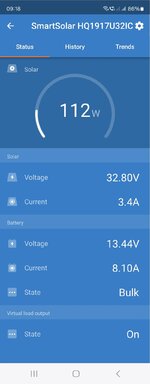haganap
LIFE MEMBER
- Dec 5, 2007
- 12,789
- 26,774
- Funster No
- 974
- MH
- Niesman+Bischoff 79e
- Exp
- I'm an oldbie MH number 10
So i have the king of all set ups...
The top of the range rolls Royce of gadgets..
I'm used to much simpler things, battery amps out, solar rate in.
Battery voltage left..
Am i reading mine correct? I've got an app with loads of things on, what do they mean?
Earlier the soc was 73% within an hour back to 100 percent..
Anyone want to guide me through the numbers and what they mean.. of you need anything else I'll add it..
But I'm just looking to understand what it all means.





The top of the range rolls Royce of gadgets..
I'm used to much simpler things, battery amps out, solar rate in.
Battery voltage left..
Am i reading mine correct? I've got an app with loads of things on, what do they mean?
Earlier the soc was 73% within an hour back to 100 percent..
Anyone want to guide me through the numbers and what they mean.. of you need anything else I'll add it..
But I'm just looking to understand what it all means.




